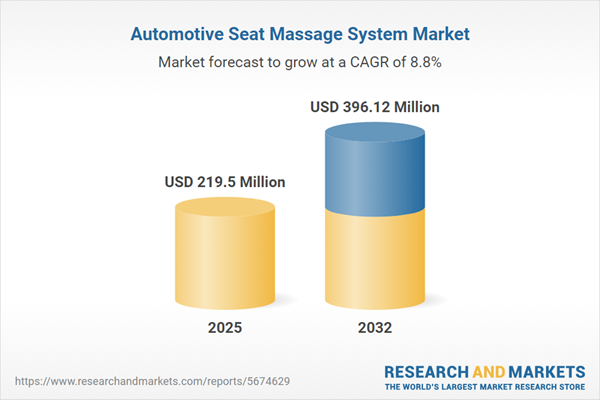Speak directly to the analyst to clarify any post sales queries you may have.
The automotive seat massage system market is experiencing robust transformation, with evolving passenger expectations, integration of in-vehicle wellness, and adaptive technologies shaping its direction. Senior decision-makers will benefit from a focused review of the key trends propelling this sector forward.
Market Snapshot: Automotive Seat Massage System Market Size and Growth
The automotive seat massage system market grew from USD 201.70 million in 2024 to USD 219.50 million in 2025 and is projected to expand at a CAGR of 8.80%, reaching USD 396.12 million by 2032. This performance highlights rising demand across both commercial fleets and private vehicles, as wellness and comfort become critical components in automotive design and purchase decisions. The primary keyword, "automotive seat massage system market," reflects a sector gaining momentum through technology adoption and market penetration.
Scope & Segmentation: Exploring Market Diversity
This research delivers actionable intelligence by examining comprehensive market dimensions and segmentation:
- Distribution Channels: Aftermarket solutions for retrofitting and OEM integration in new assembly lines.
- Vehicle Types: Passenger vehicles (including sedans, coupes, SUVs, hatchbacks) and commercial vehicles (buses, trucks, vans).
- Propulsion Methods: Electric vehicles, hybrid vehicles, and internal combustion engine models, each presenting distinct energy or integration priorities.
- Technology Types: Mechanical massage for precise pressure, pneumatic solutions for gentle distribution, and vibration modules for streamlined stimulation.
- Vehicle Classes: Economy, luxury, mid-segment, and premium options with varying feature depth.
- Seat Positions: Front seats with maximal functionality; rear seats with increasing feature adoption, especially in high-end models.
- Regional Coverage: Americas (North America, Latin America including United States, Canada, Mexico, Brazil, Argentina, Chile, Colombia, Peru), Europe Middle East & Africa (with significant hubs such as Germany, UK, Italy, UAE, South Africa, and Nigeria), and Asia-Pacific (driven by China, India, Japan, Australia, South Korea, and Southeast Asian growth markets).
- Key Companies Studied: Adient plc, Lear Corporation, Magna International Inc., Forvia SE, Toyota Boshoku Corporation, Grupo Antolin International S.A., TS Tech Co. Ltd., NHK Spring Co. Ltd., Grammer AG, and Aisin Seiki Co. Ltd.
Key Takeaways for Strategic Decision-Makers
- Automotive seat massage technology has shifted from basic comfort tools to advanced wellness-centric solutions that connect with vehicle telematics and personalized user data.
- Technological integration now supports adaptation for multiple regions and propulsion types, including energy-efficient designs for electric vehicles and robust solutions for commercial fleets.
- The competitive environment is marked by collaborative partnerships between OEMs, wellness technology providers, and software developers, accelerating time-to-market and enhancing feature differentiation.
- User experience is further enhanced by cloud-enabled comfort orchestration, transitioning from manual controls to adaptive, data-driven interfaces with personalized profiles.
- Regional market diversification strategies accommodate regulatory frameworks and consumer preferences, emphasizing modular architecture and local manufacturing to manage supply chain complexity.
Tariff Impact and Supply Chain Realignment
Recent shifts in U.S. tariffs have prompted manufacturers and suppliers to realign production footprints and sourcing strategies. Local production, regional partnerships, and increased vertical integration are reducing exposure to changing import duties, streamlining supply chains, and supporting more consistent cost structures. This environment has also accelerated cost management efforts through standardized modules and near-sourcing in tariff-exempt jurisdictions.
Research Methodology & Data Sources
This analysis combines comprehensive primary interviews with OEM engineers, component suppliers, and technical experts, alongside detailed secondary research from technical journals, patents, compliance documents, and whitepapers. Rigorous triangulation and peer review ensure accuracy and actionable depth in market forecasts and strategic implications.
Why This Report Matters
- Enables proactive decision-making by highlighting technological trends and strategic supplier movements in the automotive seat massage system market.
- Supports risk management and regional entry strategies with in-depth coverage of regulatory shifts, tariff developments, and local manufacturing best practices.
- Equips leaders to anticipate changing consumer preferences, adapt product portfolios, and capitalize on emerging wellness-driven market differentiators.
Conclusion
This report delivers a concise perspective on the technologies and strategies shaping global adoption and competitive positioning in automotive seat massage systems. Leaders will find essential guidance for navigating technological innovations, responsive supply chains, and evolving wellness expectations.
Additional Product Information:
- Purchase of this report includes 1 year online access with quarterly updates.
- This report can be updated on request. Please contact our Customer Experience team using the Ask a Question widget on our website.
Table of Contents
3. Executive Summary
4. Market Overview
7. Cumulative Impact of Artificial Intelligence 2025
Companies Mentioned
The companies profiled in this Automotive Seat Massage System market report include:- Adient plc
- Lear Corporation
- Magna International Inc.
- Forvia SE
- Toyota Boshoku Corporation
- Grupo Antolin International, S.A.
- TS Tech Co., Ltd.
- NHK Spring Co., Ltd.
- Grammer AG
- Aisin Seiki Co., Ltd.
Table Information
| Report Attribute | Details |
|---|---|
| No. of Pages | 194 |
| Published | November 2025 |
| Forecast Period | 2025 - 2032 |
| Estimated Market Value ( USD | $ 219.5 Million |
| Forecasted Market Value ( USD | $ 396.12 Million |
| Compound Annual Growth Rate | 8.8% |
| Regions Covered | Global |
| No. of Companies Mentioned | 11 |









